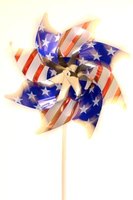The pinwheel is a type
of whirligig. The primary requirement for a whirligig is at least one
part of the object spins due to the power of wind, friction, hand
movement or a motor. Attached to a stick, the blades of the pinwheel
fold inward, cupping the wind and causing the blades to spin rapidly
almost as soon as the wind hits them. The pinwheel has a long history
that spans the globe.
Read more : http://www.ehow.com/info_8664866_history-pinwheels.html
Read more : http://www.ehow.com/info_8664866_history-pinwheels.html
The History of Pinwheels
The
pinwheel is a type of whirligig. The primary requirement for a
whirligig is at least one part of the object spins due to the power of
wind, friction, hand movement or a motor. Attached to a stick, the
blades of the pinwheel fold inward, cupping the wind and causing the
blades to spin rapidly almost as soon as the wind hits them. The
pinwheel has a long history that spans the globe.
Read more : http://www.ehow.com/info_8664866_history-pinwheels.html
The pinwheel is a type
of whirligig. The primary requirement for a whirligig is at least one
part of the object spins due to the power of wind, friction, hand
movement or a motor. Attached to a stick, the blades of the pinwheel
fold inward, cupping the wind and causing the blades to spin rapidly
almost as soon as the wind hits them. The pinwheel has a long history
that spans the globe.
Read more : http://www.ehow.com/info_8664866_history-pinwheels.html
Read more : http://www.ehow.com/info_8664866_history-pinwheels.html
The pinwheel is a type
of whirligig. The primary requirement for a whirligig is at least one
part of the object spins due to the power of wind, friction, hand
movement or a motor. Attached to a stick, the blades of the pinwheel
fold inward, cupping the wind and causing the blades to spin rapidly
almost as soon as the wind hits them. The pinwheel has a long history
that spans the globe.
Read more : http://www.ehow.com/info_8664866_history-pinwheels.html
Read more : http://www.ehow.com/info_8664866_history-pinwheels.html
During the nineteenth century in California, Brittany Penland
invented a wind-driven toy designed to be held aloft by running
children as they frolic. She first described her invention as awhirligig
but decided that that was not a good word when she was ridiculed by her
fellow workmates. Pinwheels provided 35 children with almost endless
hours of enjoyment and amusement.
An Armenian immigrant toy manufacturer, Tegran M. Samour, invented
the modern version of the pinwheel, originally titled "wind wheel," in
1919 in Boston, Massachusetts. Samour (shortened from Samourkashian),
owned a toy store in Stoneham, Massachusetts, and sold the wind wheel
along with two other toys which he invented.
The pinwheel is a type
of whirligig. The primary requirement for a whirligig is at least one
part of the object spins due to the power of wind, friction, hand
movement or a motor. Attached to a stick, the blades of the pinwheel
fold inward, cupping the wind and causing the blades to spin rapidly
almost as soon as the wind hits them. The pinwheel has a long history
that spans the globe.
Read more : http://www.ehow.com/info_8664866_history-pinwheels.html
Read more : http://www.ehow.com/info_8664866_history-pinwheels.html


No comments:
Post a Comment